Rosario [1], the third-largest city in Argentina by population, is located 300 kilometers north of Buenos Aires on the Paraná River [2]. Rosario is known as the home of the Argentinian Flag, since it was in this city where it was raised for the first time. It is also the city that saw the birth of great athletes like Lionel Messi [3], Marcelo Bielsa [4], Luciana Aymar [5] [es], and the politician and revolutionary Ernesto Che Guevara [6]. But beyond its international figures, one of Rosario's most astonishing features is its architecture, reflecting the European immigration of the early 1800's.
Rosario has been given many nicknames; one of them is “the Argentinian Chicago”, since it was the main port for grain and it also hosted a number of Sicilian mobsters, like “Chicho Grande” and “Chicho Chico”, among others. Newspaper La Nación [7] [es] writes about this nickname:
Rosario, la ciudad que a fines del siglo XIX y principios del XX se convirtió en el principal puerto cerealero del país, no sólo albergó el paso de miles de marineros y extranjeros, sino que también cobijó otro tipo de desembarco, el de la prostitución. Fue el trampolín de la mafia en el país y, de allí, el bautismo de “la Chicago argentina”.
Las andanzas de los italianos Juan Galiffi, apodado “el Chicho Grande”, y su rival, Francisco Morrone, “Chicho Chico”, inspiraron el cambio de nombre acorde con los niveles de violencia y corrupción que los envolvían.
Rosario, the city that in the late nineteenth and early twentieth centuries became the country's main grain port, not only hosted the passage of thousands of sailors and foreigners, but also harbored other type of landings, such as prostitution. It was the springboard of the mafia in the country and, hence, it was baptized as the “the Argentinian Chicago.”
The adventures of the Italian John Galiffi, nicknamed “Chicho Grande”, and his rival Francis Morrone, “Chicho Chico”, inspired the name change due to the levels of violence and corruption present at the time in the city.
After visiting Rosario, journalist Nicolas Pasiecznik writes in his personal blog [8][es] about the buildings’ domes:
De estilo neoclásico, barroco, con reminiscencias italianas, vanguardistas y hasta en algunos casos eclécticas, estas cúpulas son, además de un patrimonio de calidad excelentemente cuidado y revalorizado, una muestra del poderío económico que la zona tuviera antaño.
Neoclassical, baroque, with Italian reminiscences, vanguardist and even eclectic in some cases, these domes are not only an excellent heritage that is excellently cared for and appreciated, but also a sign of the economic strength that the area once had.
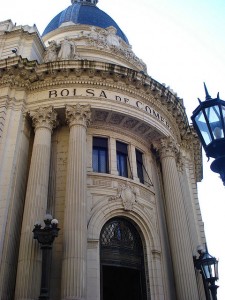
Rosario Stock Exchange building, constructed in year 1929, neoclassical style, emblem of multiple financial transactions. Photo: Ines (CC BY-NC-ND 2.0)
Another piece of architecture that shows Argentina's wealth of agricultural activity is the building “La Agrícola”, built in 1907 and located opposite the Stock Exchange. This corner is known as “the corner of the three domes.”
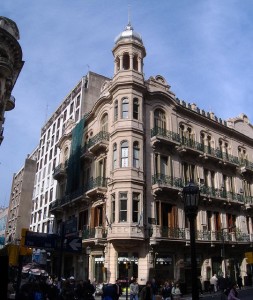
Building La Agrícola. Photo: pablodf (CC BY-NC-ND 2.0)
Another building declared a Historic National Monument is the Spanish Club [9] [es]. Its website comments about the history of this building's construction:
El edificio se comenzó a construir el 1912, contratando para ello al Arq. Francisco Roca i Simó graduado en 1906 en Barcelona.El edificio se inaugura oficialmente el 9 de Julio de 1916, una fecha singular para la historia del país: el Centenario de Independencia.
En la construcción se reconocen tres partes: la anterior, la central y la posterior, que presentan modos particulares de resolver los espacio. Pero a su vez la organización de las funciones se realiza a partir de un eje longitudinal imaginario que divide la organización de las partes en dos.
The building was built in 1912, by architect Francisco Roca i Simó, who graduated in 1906 in Barcelona. The building was officially inaugurated on July 9, 1916, a date unique to the country's history: the Centennial of its Independence .
In the construction one recognizes three parts: anterior, central and posterior, which present particular ways of solving the space. But in turn the organization of its functions are set up starting from an imaginary center line that divides the organization into two parts.
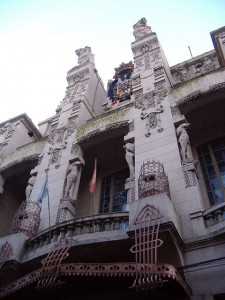
Spanish Club. Photo: pablodf (CC BY-NC-ND
The page continues with the description of the facade:
La fachada se presenta como un imponente juego de volúmenes quebrando y ahuecando el plano del mismo. A simple vista se reconocen tres partes en la organización de los elementos ornamentales, un basamento, un desarrollo y un imponente remate donde el comprometido coronamiento del edificio. Se destaca, este último segmento por la idea de colocar el escudo policromo, custodiado por dos imponentes leones, representando de la monarquía española.
The facade is presented as an impressive game of volumes breaking and hollowing the surface. At first glance, viewers recognize three parts in the organization of the ornamental elements, a base, middle, and an impressive finish where the crowning of the building is involved. This last segment stands out due to the placement of the polychrome shield, guarded by two imposing lions, representing the Spanish monarchy.
The blog Noticias de la ciudad de Rosario [10] [es] comments about another emblematic building in the city, the Cabanellas Palace:
El Palacio Cabanellas, en la esquina de Sarmiento y San Luis. Art Nouveau, o Modernisme según los catalanes. El edificio lo diseñó Francesc Roca i Simó, que vino de Mallorca y Barcelona a Rosario a principio del siglo XX, se quedó menos de una década y no paró de planear fastuosos edificios como éste.
The Cabanellas Palace, at the corner of Sarmiento and San Luis. Art Nouveau or Modernisme according to Catalans. The building was designed by Francesc Roca i Simó, who came from Majorca and Barcelona to Rosario in the early twentieth century. He stayed in Rosario less than a decade and never stopped planning lavish buildings like this one.
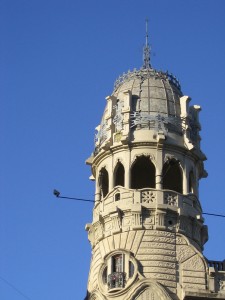
Cabanellas Palace Dome. Photo: lu6fpj (CC BY-NC-SA 2.0)
The city's architecture is no stranger to the political activity of Rosario. The Municipality is located in the Lions Palace [11] [es] (“Palacio de los Leones” in Spanish), inaugurated in 1898, and located very close to the Flag Monument [12] [es] and the Paraná River. Various stories have been passed on about this building. The best known story is about the ghost Yolanda, who, as the website El Ciudadano Web [13] [es] explains, appears in the building:
Un inspector de tránsito de la Municipalidad, Lucio Montenegro, aseguró haber visto un fantasma en el Palacio de los Leones el pasado 20 de junio. Según contó el protagonista del hecho a Elciudadanoweb.com, se encontraba trabajando en Santa Fe y Córdoba por el Día de la Bandera, y pidió permiso para entrar al baño de la Municipalidad de Rosario. Montenegro subió al primer piso y ahí fue cuando ocurrió el tenebroso episodio. Un fantasma le tocó el hombro y le dijo: “Soy Yolanda. Decile al sereno que deje la luz prendida”.
A traffic inspector of the Municipality, Lucio Montenegro, said he saw a ghost in the Palace of the Lions on June 20. He told Elciudadanoweb.com he was working in Santa Fe and Cordoba for Flag Day and requested permission to enter the bathroom of the Municipality of Rosario. Montenegro went upstairs, where the scary episode took place. A ghost touched his shoulder and said, “I am Yolanda. Tell the guard to leave the lights on”.
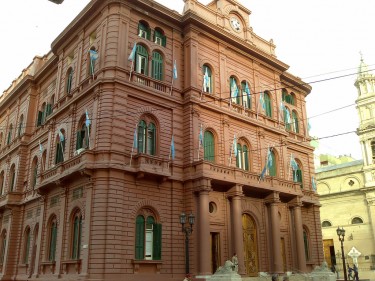
Rosario Municipality – Lions Palace. Photo: maxid (CC BY-NC-ND 2.0)
Finally, on its website Rutas Modernistas en Rosario [14](Modernist Routes in Rosario), the Municipality of Rosario shares more images for those who want to continue this virtual tour of the city and its architecture.